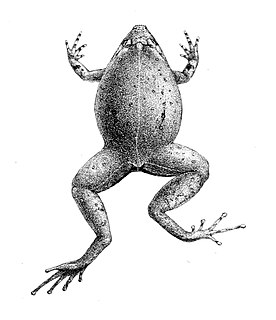
The Microhylidae, commonly known as narrow-mouthed frogs, are a geographically widespread family of frogs. The 683 species are in 63 genera and 11 subfamilies, which is the largest number of genera of any frog family.

Nyctimystes is a genus of tree frogs in the family Pelodryadidae. They are principally Papuan species, but also inhabit islands in the Moluccas. All species in this genus have one distinct feature that separates them from other species in the family, the lower eyelid is marked with pattern of lines, veins, or dots. This feature presumably acts as camouflage when the frogs are at rest during the day.

Asterophryinae is a subfamily of microhylid frogs distributed in an area from the Peninsular Malaysia through the Malay Archipelago to northern Australia.

Barygenys is a genus of microhylid frogs. They are endemic to New Guinea and the adjacent Louisiade Archipelago. So far only known from Papua New Guinea, the range of the genus is expected to reach Papua province in the Indonesian part of New Guinea. Despite not being known from Papua, common name Papua frogs has been suggested for them.
Hylophorbus is a genus of microhylid frogs endemic to New Guinea. Common name Mawatta frogs has been coined for them.

Xenorhina is a genus of microhylid frogs. The genus is endemic to New Guinea. They are sometimes known as the snouted frogs or fanged frogs, the latter referring to the now-synonymized genus Xenobatrachus.

Aphantophryne is a genus of microhylid frogs found in New Guinea and in Mindanao, the Philippines. Originally described by Fry in 1917, Richard G. Zweifel considered in 1956 Aphantophryne synonymous to Cophixalus. The genus was resurrected in 1989 to house two new species in addition to the type species, A. pansa. A molecular study on the subfamily Asterophryinae in 2017 revealed that two species originally included in the genus Oreophryne were more closely related to Aphantophryne than to other Oreophryne, and were consequently moved to this genus. The study also revealed a number of undescribed species.

Austrochaperina is a genus of microhylid frogs found on New Guinea, New Britain and Australia.

Choerophryne is a genus of microhylid frogs, commonly known as Torricelli mountain frogs, endemic to New Guinea. These frogs are small, with the body length measured from snout to vent between 11–23 mm.
Copiula is a genus of microhylid frogs endemic to New Guinea. The common name Mehely frogs has been coined for them. They are leaf-litter inhabitants.

Ctenophryne is a genus of microhylid frogs. They occur in southern Central America and South America. Their common names are egg frogs and Nelson frogs, the latter applying to species in the formerly recognized Nelsonophryne.
Austrochaperina adamantina is a species of frog in the family Microhylidae. It is endemic to New Guinea and occurs in the Torricelli and Bewani Mountains in the West Sepik Province, Papua New Guinea. The specific name adamantina is Latin for "like a diamond" and refers to Jared Diamond, credited as the collector of the holotype and "great many other valuable herpetological specimens from Papua New Guinea".
Austrochaperina blumi is a species of frog in the family Microhylidae. It is endemic to New Guinea and known from the northern slopes of the New Guinean Central Range in Western New Guinea (Indonesia), and from the Bewani, Torricelli, and Hunstein Mountains in Papua New Guinea. The specific name blumi honors J. Paul Blum, the herpetologist who collected the type series. Common name Kosarek land frog has been proposed for it.

Sphenophryne thomsoni, sometimes known as Thomson's toothless frog, is a species of frog in the family Microhylidae. It is endemic to Papua New Guinea and occurs in the southeastern peninsular New Guinea, Louisiade Archipelago, d'Entrecasteaux Islands, and Woodlark Island. It was formerly in its own monotypic genus Genyophryne. The specific name thomsoni honours Basil Thomson, a British intelligence officer, police officer, prison governor, colonial administrator, and writer.

Sphenophryne similis is a species of frog in the family Microhylidae. It is endemic to New Guinea and is only known from its type locality in the Owen Stanley Range, Northern Province, Papua New Guinea.
Aphantophryne parkeri is a species of frog in the family Microhylidae. It is endemic to the north coast of New Guinea and only known from Matapan and the Bewani Mountains in the West Sepik Province, Papua New Guinea, and from Sentani in the Papua Province, Western New Guinea (Indonesia). This species was formerly included in the genus Oreophryne, but was in 2017 moved to Aphantophryne based on molecular data. The specific name parkeri honours Hampton Wildman Parker, an English zoologist and herpetologist. Common name Parker's cross frog has been coined for it.
Sphenophryne crassa is a species of frog in the family Microhylidae. It is endemic to eastern New Guinea and is known from the Mount Dayman and Mount Simpson in the Owen Stanley Range, Papua New Guinea. Common name Papua land frog has been proposed for it.

Sphenophryne cornuta is a species of frogs in the family Microhylidae. It is endemic to New Guinea where it is widespread and found both in the Western New Guinea (Indonesia) and Papua New Guinea. Common name horned land frog has been proposed for it.

Cornufer is a genus of frogs in the family Ceratobatrachidae. It has been greatly expanded by Brown, et al. (2015) to include most Australasian frogs in the family Ceratobatrachidae. Species are found in Melanesia and Polynesia — in Palau, Fiji, New Guinea, and in the Admiralty, Bismarck, and Solomon Islands.

Ranoidea is a genus of frogs in the subfamily Pelodryadinae. They are found in Australia, New Guinea, and two nearby groups of islands: the Maluku Islands, and the Louisiade Archipelago. The circumscription of this taxon is still controversial.













